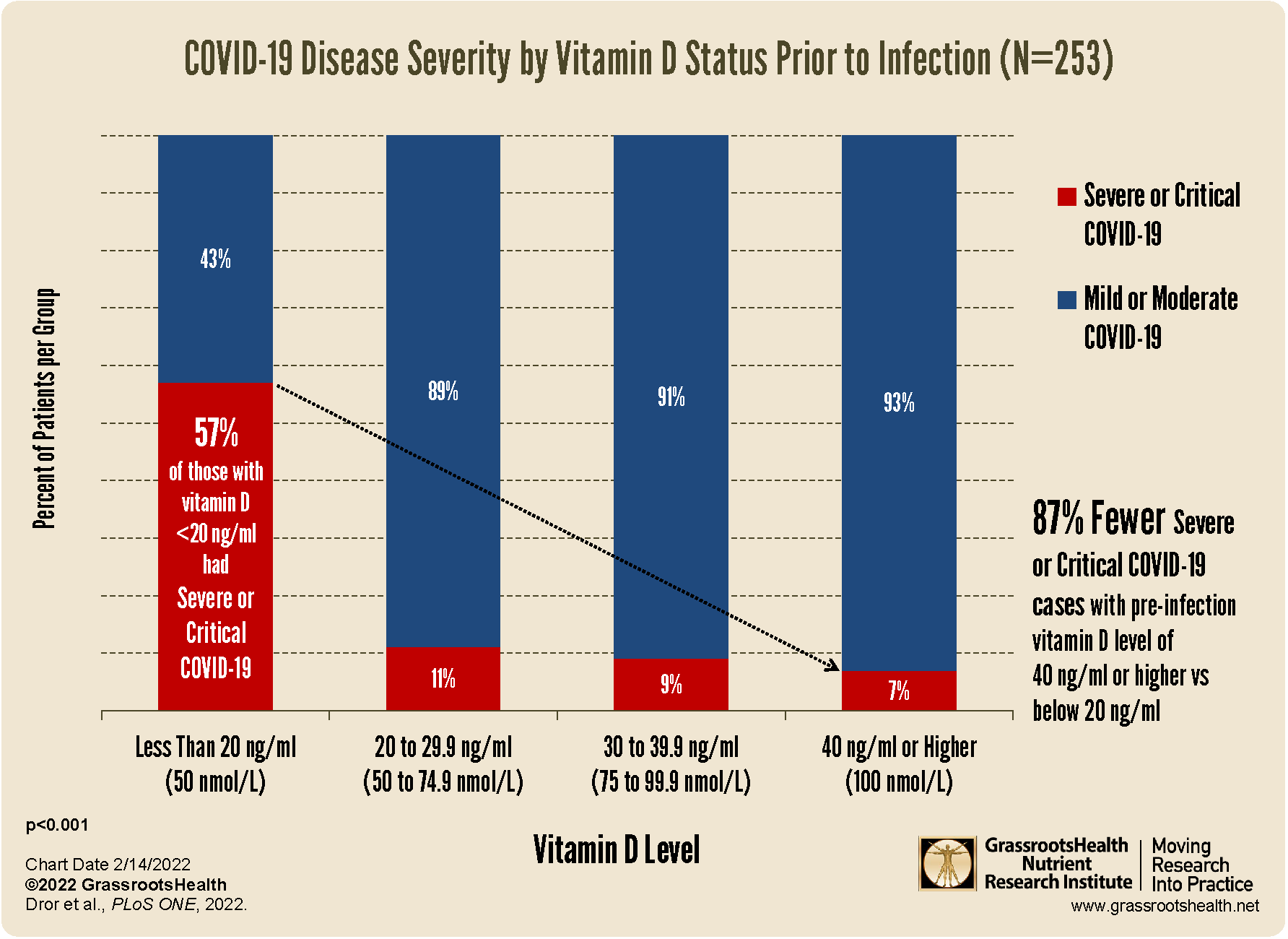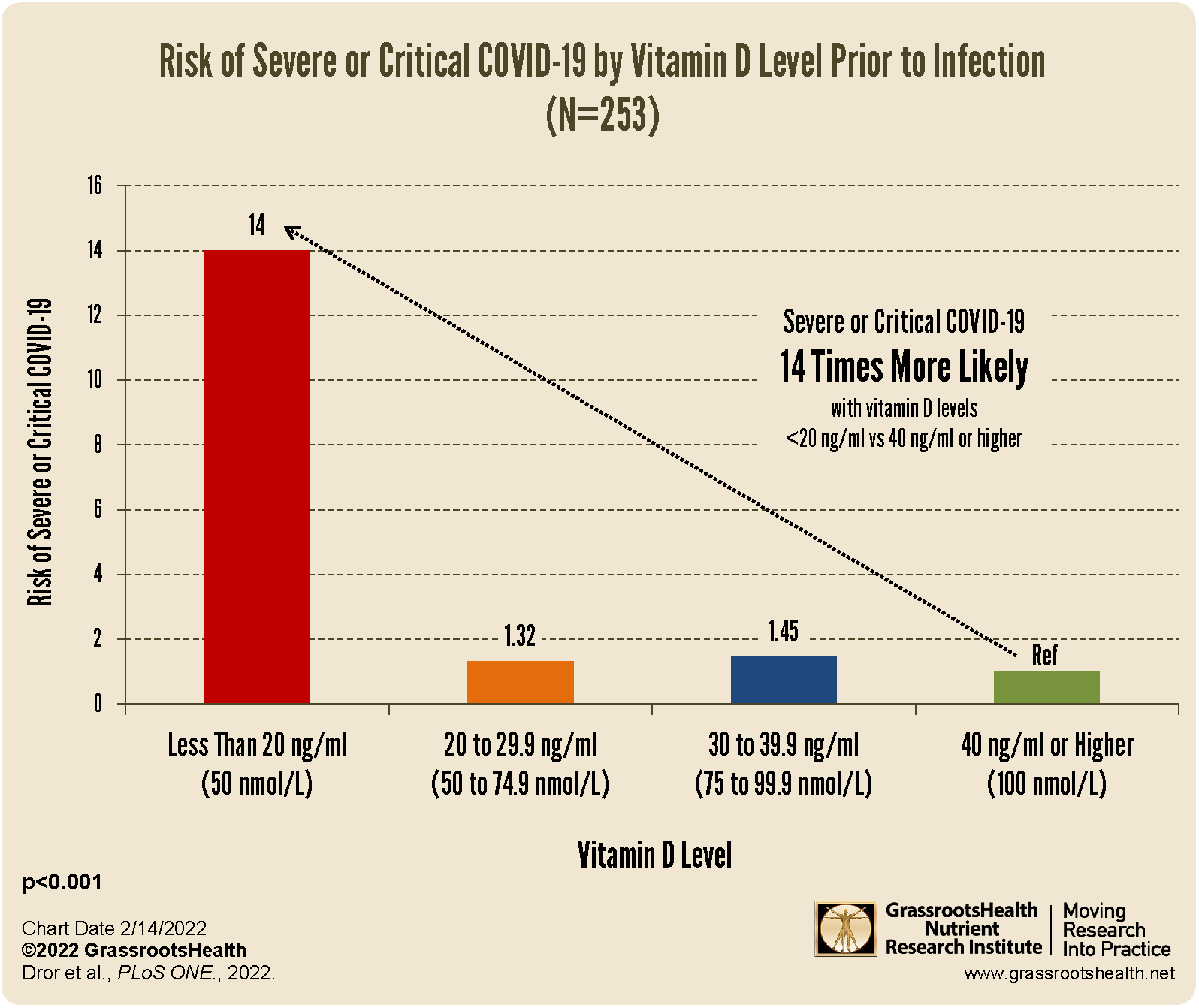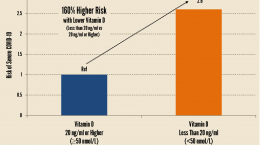Published on February 15, 2022
Study finds strong correlation between COVID-19 severity and pre-infection vitamin D level, especially for patients 50 years or older
Key Points
- A new study looked at pre-infection vitamin D levels among 253 patients hospitalized with COVID-19, and compared those levels to COVID-19 disease severity
- Patients were divided into four categories based on their measured pre-infection vitamin D level and their vitamin D level predicted for their month of COVID-19 diagnosis; the category distribution and the findings were similar for both groups
- The study found that 57% of those with pre-infection vitamin D levels below 20 ng/ml ended up with severe or critical COVID-19, severe or critical COVID-19 was 87% less likely among patients whose pre-infection vitamin D level was at least 40 ng/ml compared to below 20 ng/ml, and patients with pre-infection vitamin D levels below 20 ng/ml were 14 times more likely to have severe/critical COVID-19 compared to those at or above 40 ng/ml
- Further analysis found the strongest correlation between vitamin D level and COVID-19 disease severity among those who were 50 years or older
 Many studies have now been published showing a clear association between vitamin D levels and the risk and severity of COVID-19 disease.
Many studies have now been published showing a clear association between vitamin D levels and the risk and severity of COVID-19 disease.
Another study by Dror et al. looked at pre-infection vitamin D levels among 253 patients hospitalized with COVID-19, and compared those levels to COVID-19 disease severity. Vitamin D levels had been measured anywhere from 14 to 730 days prior to COVID-19 diagnosis, and a statistical model was used to account for seasonal variability and predict the average vitamin D level of each patient by year and month. Patients were divided into four categories based on their measured pre-infection vitamin D level and their vitamin D level predicted for their month of COVID-19 diagnosis; the category distribution and the findings were similar for both groups.
What did the study find?
Based on the measured pre-infection vitamin D levels, over half had levels below 20 ng/ml (50 nmol/L). When divided into categories, 52.5% of patients were below 20 ng/ml (50 nmol/L), 14.2% were between 20 and 29.9 ng/ml (50-74.9 nmol/L), 17.3% were 30-39.9 ng/ml (75-99.9 nmol/L), and 15.8% had levels of 40 ng/ml (100 nmol/L) or higher.
In this analysis, the authors found that
57% of those with pre-infection vitamin D levels below 20 ng/ml ended up with severe or critical COVID-19,
severe/critical COVID-19 was 87% less likely among patients whose pre-infection vitamin D level was at least 40 ng/ml compared to below 20 ng/ml (p<0.001),
patients with pre-infection vitamin D levels below 20 ng/ml were 14 times more likely to have severe/critical COVID-19 compared to those at or above 40 ng/ml (p<0.001),
and the COVID-19 mortality rate among those with pre-infection vitamin D levels below 20 ng/ml was 25.6% compared to 5% or lower in the patients with higher vitamin D levels (p<0.001).
The analysis using the predicted vitamin D level at the month of COVID-19 diagnosis showed consistently similar results to those using the actual measurements – that COVID-19 disease severity worsened with lower predicted vitamin D levels.
Age Affected Strength of Correlation between Vitamin D and COVID Severity
Besides vitamin D level, age was also a consistently independent risk factor for severe COVID-19 disease. In fact, further analysis found the strongest correlation between vitamin D level and COVID-19 disease severity among those who were 50 years or older (p<0.001), although the relationship was significant for the younger age groups as well.
What is YOUR Vitamin D Level?
 Having and maintaining healthy vitamin D levels and other nutrient levels can help improve your health now and for your future. Choose which to measure with vitamin D, such as your Omega-3 Index, omega fatty acid ratios, and essential minerals including magnesium and zinc, by creating your custom home test kit today. Take steps to improve the status of each of these measurements to benefit your overall health. You can also track your own intakes, symptoms and results to see what works best for YOU.
Having and maintaining healthy vitamin D levels and other nutrient levels can help improve your health now and for your future. Choose which to measure with vitamin D, such as your Omega-3 Index, omega fatty acid ratios, and essential minerals including magnesium and zinc, by creating your custom home test kit today. Take steps to improve the status of each of these measurements to benefit your overall health. You can also track your own intakes, symptoms and results to see what works best for YOU.
Enroll and test your levels today, learn what steps to take to improve your status of vitamin D (see below) and other nutrients and blood markers, and take action! By enrolling in the GrassrootsHealth projects, you are not only contributing valuable information to everyone, you are also gaining knowledge about how you could improve your own health through measuring and tracking your nutrient status, and educating yourself on how to improve it.







